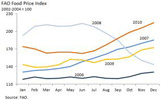Price Volatility in Food and Agricultural Markets: Policy Responses

Under the Food Security pillar of the Seoul Multi-year Action Plan on Development, the G20 “request that FAO, IFAD, IMF, OECD, UNCTAD, WFP, the World Bank and the WTO work with key stakeholders to develop options for G20 consideration on how to better mitigate and manage the risks associated with the price volatility of food and other agriculture commodities, without distorting market behaviour, ultimately to protect the most vulnerable”. This report has been prepared by FAO, IFAD, IMF, OECD, UNCTAD,WFP, the World Bank, the WTO, IFPRI and the UN HLTF.
The approach taken in this report reflects the view of the collaborating international organisations that price volatility and its effects on food security is a complex issue with many dimensions, agricultural and non-agricultural, short and long-term, with highly differentiated impacts on consumers and producers in developed and developing countries. The report begins with a discussion of volatility and of the ways in which volatility affects countries, businesses, consumers and farmers. Lessons learned from recent experiences are briefly reviewed as well as the factors determining likely levels of volatility in future. This report offers suggestions for a systematic and internationally coordinated response building on the lessons learned as a result of the 2007-2008 crisis.
It is important to distinguish between policy options designed to prevent or reduce price volatility and those designed to mitigate its consequences. Both types of intervention are explored in detail. Scope is identified for actions at individual, national, regional and international level. Some would help to avert a threat, others are in the nature of contingency plans to improve readiness, while still others address long-term issues of resilience. Finally, the report explores mechanisms of international cooperation to implement this report?s recommendations and to monitor progress